The project CamachoNet, funded through a grant awarded by the IEEE Humanitarian Activities Committee, is implementing a regional network in the Bolivian highlands. The network is located approximately six hours from the capital La Paz, on the outskirts of Lake Titikaka at a height of 4200 meters (2.6 miles) above sea level. The project will connect a main hospital to remote health centers and posts; it will also include regional connectivity for schools and villagers through WiFi hotspots. The network includes various point-to-point links of over 20Km (13 miles).
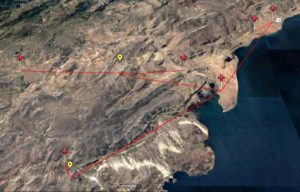
The figure shows the point-to-point links that connect remote villages among them.
Internet connectivity in rural areas is still a challenge that nations and society face and will face for the next decades. It has been suggested that universal Internet access will not be possible until 2050. This is complicated by the quality of service in rural areas, affordability, the lack of meaningful local content and the incentives to create it, and the lack of digital entrepreneurship.
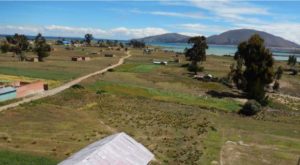
The picture illustrates a village that is being linked to the network. These villages are characterized by a small population density, which is not attractive to telecoms.
Bolivia has had a great progress in Internet connectivity in rural areas; however these still face the aforementioned challenges. Remote health centers are affected the most: these are served by inexperienced doctors or nurses; when extreme cases arise, consultation with specialists in main hospitals becomes impossible due to the lack of Internet connectivity or inadequate bandwidth. The lack of appropriate health care has translated into mother and child deaths – Bolivia has one of the highest maternal child mortality rates in the hemisphere. The central government has provided expensive telemedicine equipment; however it is not operational because the communities cannot meet the budget necessary to purchase satellite Internet connectivity. The area of education is also impacted: while a child living in the capital might be raised with state of the art communication technologies, a child living in rural areas is not exposed to the same technologies. In ten years this will be translated into a lack of opportunities, an educational and socio-economic gap, and a low likelihood that the student would study technology-related disciplines.

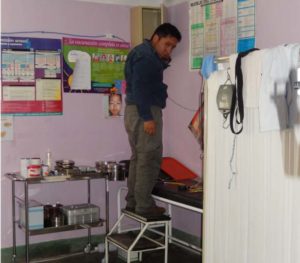
The remote village of Challapata was connected to the network in the first stage of the project. Nurses were able to communicate through high-definition video with health centers. The second stage is bettering services.
Fueled entirely by IEEE and student volunteers, CamachoNet taps local innovation and know-how in order to address issues that international organization have had difficulty addressing. It also enables socio-technical processes with grass-roots components that are unprecedented. It is an international development project fueled by hundreds of IEEE volunteers that want to make a difference in their own nation and reproduce the blueprint elsewhere. “The CamachoNet project has provided me the opportunity to put into practice the knowledge I have acquired at the university through real-life platforms where I also have a great responsibility. It also has provided me the chance to help the people that need the most while also enhancing my knowledge in the areas where I did not have much experience before, telecommunications and networking,” states Hector Iñiguez, a very passionate volunteer that specializes in digital forensic work.
 Some of the CamachoNet volunteers proudly acknowledging the role of IEEE after a day-long design meeting.
Some of the CamachoNet volunteers proudly acknowledging the role of IEEE after a day-long design meeting.
While the project seems a technical one, the reality is otherwise. IEEE volunteers have spent months socializing the project with the communities and their leadership; they have carried out social science baselines in order to analyze the needs and eventually measure the impact of the project; they have also researched on technologies and platforms that will be more appropriate for such needs. The inclusion of local entrepreneurs for the provision of services is a great start towards the creation of local content. “This project has opened doors and allowed me to meet and share with students from various universities and professions. I specialize in computer science, but my principal role is to socialize the project with members of the remote communities so they provide us with land and infrastructure; I did not have any idea on how to carry out socialization before I joined CamachoNet. It also helped me to work in teams. I’m looking forward to continuing the development and see how telecommunications is going to help people, save lives and provide opportunities to poor people. There are no words to describe how surprised I am to see that these kinds of projects exist and I’m part of one of them,” proudly states Ismael Sullcamani, a volunteer that is one of the project socialization stars.
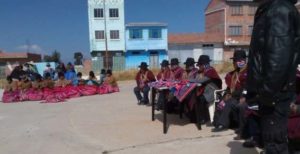 Socialization included taking part in community meetings to present the project and sign agreements.
Socialization included taking part in community meetings to present the project and sign agreements.
This project is an example of how local resources and know-how can provide grass roots approaches to challenges that otherwise would be provided only by private telecoms. IEEE HAC expects that once this project will be finished, it will be a product that could be reproduced anywhere in the country and elsewhere. The project not only seeks to provide connectivity, but also local content through the implementation of a microdatacenter that will house thousands of videos and other relevant material. A fundamental issue that the regional delivery of services addresses is the need to have certain level of resource sovereignty in the light of natural disasters, Internet main connection 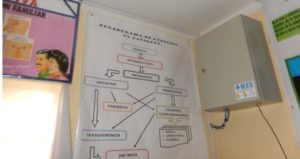 points and other issues. “The locals have complained of their need to download community videos from foreign resources if these videos can be stored locally and served through community hotspots; this would also save them the expensive bandwidth costs,” states Jaime Montecinos, a volunteer that has led many working groups from the outset of the project and is now in charge of the development of the microdatacenter.
points and other issues. “The locals have complained of their need to download community videos from foreign resources if these videos can be stored locally and served through community hotspots; this would also save them the expensive bandwidth costs,” states Jaime Montecinos, a volunteer that has led many working groups from the outset of the project and is now in charge of the development of the microdatacenter.
Infrastructure installed in the first stage of the project. Current implementation will better such infrastructure.
This project also addresses a large gap in the technology ecosystem in Bolivia. Electrical and electronics engineers rarely work in areas related to their very field. Through this project students have the opportunity to design regional networks, design micro datacenters that will be housed in the communities, carry out complex logistical operations, and develop their leadership skills through forming part of committees, working groups and implementation teams. Opportunities are plenty for  students who want to make a difference. “CamachoNet has given us a platform to develop our leadership skills, to learn how to recognize the skills and talents of team members, to learn the importance of service to others, and to combine our talents to reach a common goal: to better the living conditions of the Camacho Province,” states Guery Huanca, a very passionate volunteer that has led socialization teams.
students who want to make a difference. “CamachoNet has given us a platform to develop our leadership skills, to learn how to recognize the skills and talents of team members, to learn the importance of service to others, and to combine our talents to reach a common goal: to better the living conditions of the Camacho Province,” states Guery Huanca, a very passionate volunteer that has led socialization teams.
Around five large towers are being installed to serve over seven villages.
This project has become quite visible in Bolivia through various outreach activities. For example, Rafael Lindemann, a researcher for RIMISP (Latin American Center for Rural Development) has noticed the talent and passion of IEEE volunteers and has commissioned the design and implementation of a prototype of a rural device that senses various parameters such as temperature, humidity, wind speed/direction, and rainfall. “Tackling the digital divide between rural and urban areas in Bolivia is an important key to further advance the quality of life of communities and groups that are lagging behind. It has been very enriching to see the work the IEEE is undertaking to address digital inequality in the Camacho province. In virtue of this, RIMISP (within the Inclusive Markets Project of the Swiss and Swedish cooperation agencies in Bolivia) has opened the possibility that IEEE students design and fabricate a basic yet effective meteorology measurement device. The aim is to provide information to rural inhabitants in order to prevent natural disasters and adapt to unpredictable changes in the climate. The presentation of the first prototype was a complete success,” affirms Rafael. Volunteers are also impacted. Miriam Condori, a volunteer that has been with CamachoNet since the very beginning is now in charge of the rain measurement device and transducer, among many other responsibilities in the project. “CamachoNet has changed radically the direction of my professional and personal life, particularly because the exposure to volunteers of different fields and the friendships I have acquired. I have understood that my acquisition of professional knowledge has to have a meaningful focus; for me it is to help the people that need the most,” affirms Miriam.
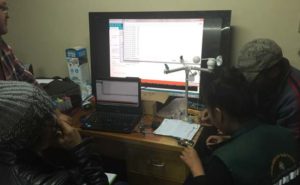 The design and implementation of a sensor prototype has taken time. Various of the volunteers study and work; it has been a sweet sacrifice for them.
The design and implementation of a sensor prototype has taken time. Various of the volunteers study and work; it has been a sweet sacrifice for them.
Outreach activities included informational booths in various events. This has allowed volunteers to meet international role models, one of them being Elena Messina, Program Manager of the Measurement Science for Manufacturing Robotics Group of the National Institute of Standards and Technology. While hosting a booth, the volunteers had the chance to meet her after one of her 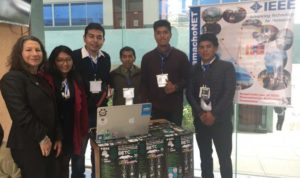 presentations for a IEEE Bolivia Section conference. “CamachoNet is an excellent example of how classroom education can make a difference in the world. The volunteers I met are extremely enthusiastic and capable and are translating what they learn in classes into real-world solutions. I am impressed by the scope and goals of CamachoNet, which is truly “Advancing Technology for Humanity,”” states Elena Messina.
presentations for a IEEE Bolivia Section conference. “CamachoNet is an excellent example of how classroom education can make a difference in the world. The volunteers I met are extremely enthusiastic and capable and are translating what they learn in classes into real-world solutions. I am impressed by the scope and goals of CamachoNet, which is truly “Advancing Technology for Humanity,”” states Elena Messina.
Meeting role models such as Elena Messina has been one of the highpoints for volunteers.
The project takes advantage of the groups already present in the Bolivia IEEE section. Various informative sessions have taken place with assistance of over 80 volunteers, a majority of them not members of the IEEE. This has been an excellent chance to promote IEEE. The different tasks are carried out through working groups where interested students of a pool of over 130 volunteers are recruited. For instance, the design of the overall network, the determination of the height of towers, the need of repeaters in nearby hills, the types of antennas needed for high bandwidth and others has been carried out by volunteers interested in this very topic. There were volunteers very knowledgeable in the topic which helped immensely in this endeavor.
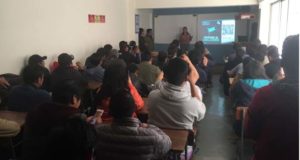
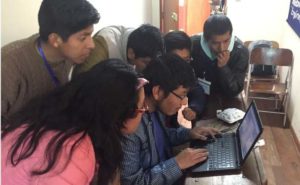
IEEE leadership has been active in socializing IEEE membership and interest groups to CamachoNet volunteers.
For more information about the project contact info@camachonet.org.
Article written by Martin Murillo, IEEE Bolivia Section volunteer and CamachoNet team leader.

